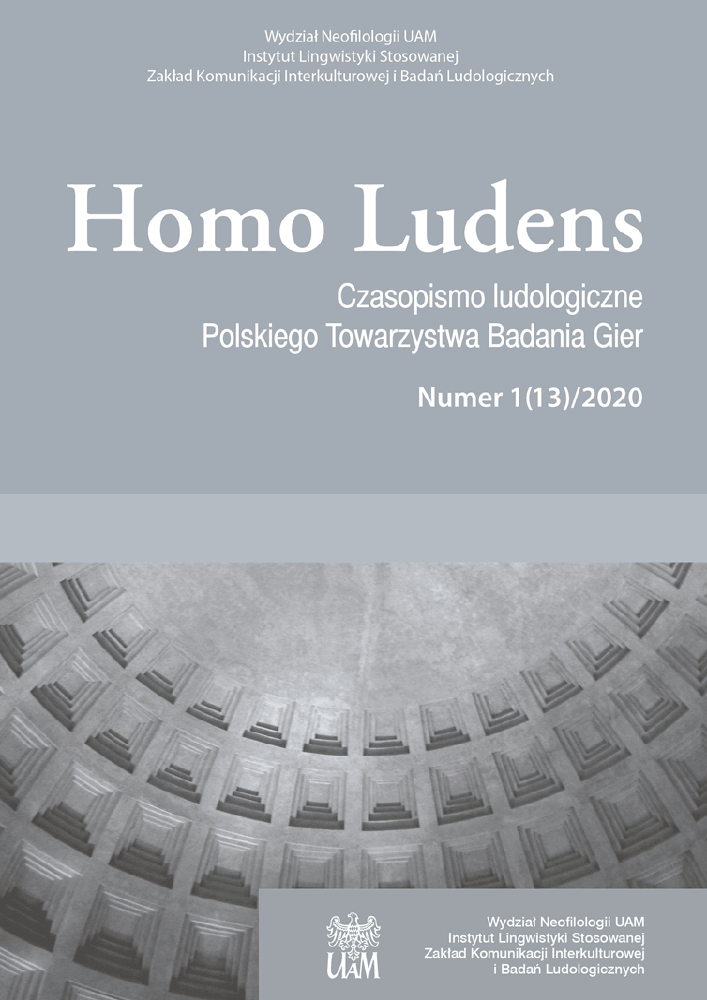Abstract
Linguistics deals with communication and its pragmatic effects in terms of dynamic changes in human relationships fostered by the information circulated between the interacting parties. Such relationships may be especially complex in the inter-cultural context, when certain information belonging to the source environment may not be clear to the participants functioning in the target environment. Communication may relate to the facts verified with solely technical means, but also to the unverifiable convictions, views and stereotypes. Its specific manifestation in the contemporary circulation of pop-cultural (and not only) relations is the presence of orientalism-related threads. Some premises on whether such threads should be recognized as harmful and distorting the communication perspective by their very definition – and why – are presented in the paper. The methodology of game research, with reference to the psychological games and the roles of the Child, the Adult and the Parent, being alluded on purpose by the triad of the expert, non-expert and careless narratives, makes it possible to differentiate effectively the verifiable reports on facts from the narratives which, by their very definition, are not subject to verification, and which are often misleading or do not go beyond the harmful stereotypes.
References
Austin, J. L. (1962). How to Do Things With Words. Cambridge, Massachusetts: Harvard University Press.
Bator, J. (2004). Japoński wachlarz [A Japanese fan]. Warszawa: Twój Styl.
Bator, J. (2014). Rekin z parku Yoyogi [A shark of the Yoyogi Park]. Warszawa: Grupa Wydawnicza Foksal.
Bednarz, K. (2016). Samobójstwa w Japonii. Zestaw do wypadków z udziałem ludzi [Suicides in Japan: A set for dealing with accidents resulting in injury or death]. Gazeta Wyborcza. Online: <https://wyborcza.pl/duzyformat/1,127290,20558366,samobojstwa-w-japonii-zestaw-dowypadkow-z-udzialem-ludzi.html>. Accessed: 15 November 2019.
Bednarz, K. (2018). Kwiaty w pudełku [Flowers in the box]. Warszawa: Czarne.
Bednarz, K. (2019). Japońska szkoła zaciskania zębów [The Japanese school of teeth-clenching]. Pismo. Online: <https://magazynpismo.pl/japonska-szkola-edukacja-przemoc>. Accessed: 15 November 2019.
Berger, P. L., Luckmann T. (1966). The Social Construction of Reality: A Treatise in the Sociology of Knowledge. London, New York: Penguin.
Austin, J. L. (1962). How to Do Things With Words. Cambridge, Massachusetts: Harvard University Press.
Bator, J. (2004). Japoński wachlarz [A Japanese fan]. Warszawa: Twój Styl.
Bator, J. (2014). Rekin z parku Yoyogi [A shark of the Yoyogi Park]. Warszawa: Grupa Wydawnicza Foksal.
Bednarz, K. (2016). Samobójstwa w Japonii. Zestaw do wypadków z udziałem ludzi [Suicides in Japan: A set for dealing with accidents resulting in injury or death]. Gazeta Wyborcza. Online: <https://wyborcza.pl/duzyformat/1,127290,20558366,samobojstwa-w-japonii-zestaw-dowypadkow-z-udzialem-ludzi.html>. Accessed: 15 November 2019.
Bednarz, K. (2018). Kwiaty w pudełku [Flowers in the box]. Warszawa: Czarne.
Bednarz, K. (2019). Japońska szkoła zaciskania zębów [The Japanese school of teeth-clenching]. Pismo. Online: <https://magazynpismo.pl/japonska-szkola-edukacja-przemoc>. Accessed: 15 November 2019.
Berger, P. L., Luckmann T. (1966). The Social Construction of Reality: A Treatise in the Sociology of Knowledge. London, New York: Penguin.
Berne, E. (1964). Games People Play: The Psychology of Human Relationships. New York: Grove Press.
Caillois, R. (2001). Man, Play and Games (transl. M. Barash). Urbana and Chicago: University of Illinois Press.
Duszak, A. (1998). Tekst, dyskurs, komunikacja międzykulturowa [Text, discourse, inter-cultural communication]. Warszawa: Wydawnictwo Naukowe PWN.
Goffman, E. (1956). The Presentation of Self in Everyday Life. Edinburgh: University of Edinburgh.
Guiraud, P. (1975). Semiology (transl. G. Gross). London, Boston and Henley: Routledge & Kegan Paul.
Hidasi, J. (1999). Cases of Miscommunication between Europeans and Japanese. In R. Huszcza, A. Kozyra (eds.), Proceedings of Warsaw Symposium on Japanese Studies, 23–26 November 1994 (pp. 275–284). Warszawa: Dialog.
Huizinga, J. (1949). Homo Ludens: A Study of the Play-Element in Culture. London, Boston and Henley: Routledge & Kegan Paul.
Jabłoński, A. (2009). Gry, procedury, przewidywalność – w kontekście polsko-japońskiej komunikacji międzykulturowej [Games, procedures, predictability – in the context of Polish-Japanese intercultural communication]. Homo Ludens, 1(1), 103–112.
Jabłoński, A. (2013). Homeostaza tekstu. Tłumaczenie i komunikacja międzykulturowa w perspektywie polsko-japońskiej [Homeostasis of text: Translation, interpretation and intercultural communication in the Polish-Japanese perspective]. Poznań: Wydawnictwo Naukowe UAM.
Jabłoński, A. (2015). Japoński miszmasz [A Japanese mishmash]. Baranowo: Jeżeli P to Q.
Jabłoński, A. (2016). Japońskie alter ego. Jeszcze o antyinformacji w „narracjach niedbałych” [A Japanese alter ego: More on the anti-information in the ‘careless narratives’]. Homo Ludens, 9(1), 2016, 53–63.
Martin, S. E. (1964). Speech Levels in Japan and Korea. In D. Hymes (red.), Language in Culture and Society (pp. 407–415). New York, Evanston, London:
Harper & Row, Publishers.
mk (2019). Absurdalny zakaz w Japonii. Kobiety nie mogą nosić okularów. Bo tracą kobiecość [An absurd ban. Women may not wear glasses. They lack the feminine look]” Wysokie obcasy. <https://www.wysokieobcasy.pl/wysokie-obcasy/7,163229,25392156,absurdalny-zakaz-w-japonii-kobiety-nie-moga-nosic-okularow.html>. Accessed: 15 November 2019.
Nakane, C. (1970). Japanese Society. Berkeley and Los Angeles: University of California Press.
Said, E. W. (2003). Orientalism. London: Penguin.
Sugiyama-Lebra T. (1976). Japanese Patterns of Behavior. Honolulu: University of Hawaii Press.
Olewicz, B. (1994). Na co komu dziś [I don’t need today]. Lyrics online: <https://www.tekstowo.pl/piosenka,lady_pank,na_co_komu_dzis.html>. Accessed: 15 November 2019.
Rosiewicz, A. (1980). Najwięcej witaminy [Most vital]. Lyrics online: <https://www.tekstowo.pl/piosenka,andrzej_rosiewicz,najwiecej_witaminy.html>. Accessed: 15 November 2019.
Tomański, R. (2015). Japonia. Kraj przywiędłej wiśni [Japan: The country of wilted cherry blossom]. Online: <http://wyborcza.pl/magazyn/1,149044,19074844,japonia-kraj-przywiedlej-wisni.html>. Accessed: 15 November 2019.
Wierzbicka, A. (2003). Cross-Cultural Pragmatics: The Semantics of Human Interaction. Berlin: Mouton de Gruyter.
Witkiewicz, S. I. (1985). Matka [Mother]. In Dzieła wybrane. T. V. Dramaty** [selected works. Vol. 5. Dramas, part 2]. Warszawa: Państwowy Instytut Wydawniczy.

